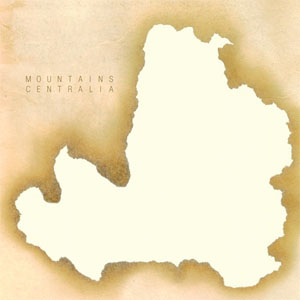Mountains Centralia
In a 2011 interview around the release of the duo’s fifth album, Air Museum, Mountains‘ […]

In a 2011 interview around the release of the duo’s fifth album, Air Museum, Mountains‘ Brendon Anderegg expressed some misgivings about the uses to which his group’s serene ambience was being put: “Three people have told us that they’ve given birth to our music. So… that’s something we’re trying to get away from.” It’s a faintly understandable, if less-than-generous reaction—perhaps receiving that information is like being told you’re the best background musician in the world. In this particular case, it’s either a case of protesting too much or misapprehending the real strengths of Mountains’ bucolic drones.
Sure enough, where Anderegg and Koen Holtkamp’s previous album, Choral, had been a thing of warm uplift and after-work decompression, Air Museum struck out for more convulsive, less comfortably backgroundable terrain. Unfortunately, the album didn’t reveal a latent talent for music that was louder and busier than the stuff they’d been making for the past six years. It sounded, instead, like they’d kept the same vocabulary and simply ramped up the volume, adopting a blustery speaking voice ill-suited to convey their usual vernal whisperings. As much as they might grit their teeth at the idea of being limited to new-age clichés, the members of Mountains also show little interest in changing their overall approach. Centralia, for the most part, goes back to the duo’s tried-and-true dynamics for a seemingly exhaustive summary of the band.
With many other groups, the level of familiarity on Centralia would be problematic. The secret advantage inherent in Mountains’ music is, contrary to Anderegg’s response, its forgetability. The album broaches the subject on its first track, “Sand,” where sunblind synth drones are played against a kind of modular-synth birdsong—the latter’s loopy, awkward coos quoting from the earlier works of the Swedish band Tape. Both bands convey the same feeling: smitten with nature, humble, good-natured, cloistered, gently transcendent, naive and fragile in a basically optimistic way. But Tape also writes melodies where Mountains contents itself to sprawl, managing its affairs from what seems to be a greater distance but is more likely to be the kind of overly close attention to detail that is too preoccupied with subtle transformations to broach something as concise as a melody.
Lyrical as they seem, Mountains’ albums are hard to remember: the cascading, John Fahey–inspired fingerpicking that’s particularly pronounced on the early-album suite of “Identical Ship,” “Circular C,” and “Tilt” is simply an engine to move these compositions along, not something built to be contemplated. But ultimately, this just means that in the home, which is without a doubt the setting best adapted to Mountains’ music, every play is both familiar and new in basic, useful ways. Atypically, the last few minutes of penultimate track “Liana” are shot through with a creeping Sunn O)))-style guitar riff, soaked in dominatingly loud, yet immaculately clean distortion. As on Air Museum, such bland, anti-comfort-zone gestures only underline the lasting value of what Mountains nailed years ago: environments that are relaxing, warm, and human enough to have babies to.

